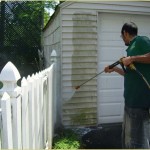 Dirt, grime and bird droppings can certainly take a toll on the exterior of your Buffalo and Rochester area home. But you can fairly quickly and easily rinse the filth away with a thorough power washing. Before we dive into power washing dos and don’ts, it’s important to note the slight distinction between power washing and pressure washing.
Dirt, grime and bird droppings can certainly take a toll on the exterior of your Buffalo and Rochester area home. But you can fairly quickly and easily rinse the filth away with a thorough power washing. Before we dive into power washing dos and don’ts, it’s important to note the slight distinction between power washing and pressure washing.
Both power washing and pressure washing use a high-pressure water stream but:
- Power washing typically uses hot water and less pressure.
- Pressure washing can use water of any temperature, relying more on water pressure than temperature to get the job done.
The tips below can be applied to either power washing or pressure washing of your Rochester-area home.
Don’t use a ladder. For obvious reasons, this is asking for trouble. Stand on the ground or a stable platform at all times.
Do be aware of the potential hazards. In addition to falling off a ladder, a high-pressure water stream can damage screens and siding, blast off paint and break seals around the windows. Water that gets behind siding or into cracks around brick and mortar can result in mold problems down the line.
Do eliminate hazards with precautions. Make sure all nearby exterior electrical components are turned off or well-protected, especially areas around the electric meter and air conditioning units. Don’t get too close to gutters or siding, and spray at an angle away from windows, vents and doors.
Don’t use bleach for general cleaning. While a diluted bleach solution applied with a sponge may be necessary for eliminating mildew, you don’t want bleach in your power washer. A general purpose, bleach-free cleaner is a more effective and safer bet – especially for any surrounding foliage. Apply the detergent with a low-pressure setting and let it soak for two to three minutes before rinsing with a higher setting.
Do protect nearby plants. Cover surrounding foliage with plastic dropcloths if the plants may come in contact with the detergent. If you can’t cover certain plants, thoroughly wetting them before you begin can help prevent detergent-related damage to the leaves.
Don’t use too high a pressure. Many of the hazards presented are due to power washing that is done too close and at too high of a pressure. While all situations are slightly different, washers with 1,300 to 1,600 psi are generally sufficient for cleaning siding or homes.
Do start at the bottom. When you’re first applying detergent start at the bottom and work your way up, always working in a small area so the detergent does not dry on the siding. Allow the detergent to rest on the siding for a few minutes and then rinse from the top, down.
Don’t spray in the wrong direction. The wrong direction for power washing is spraying upward. You instead want to spray in a downward direction to ensure water doesn’t seep beneath siding and the dirty water flows toward the ground.
As a leading home inspection company in the Buffalo and Rochester area, we’ve seen the positive effects power washing can have on the overall appearance of a home. Power washing units have become inexpensive enough to consider purchasing one if you’ll need it regularly, or you can always rent one on an as-needed basis.


